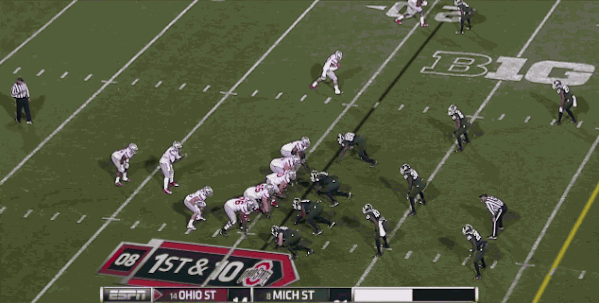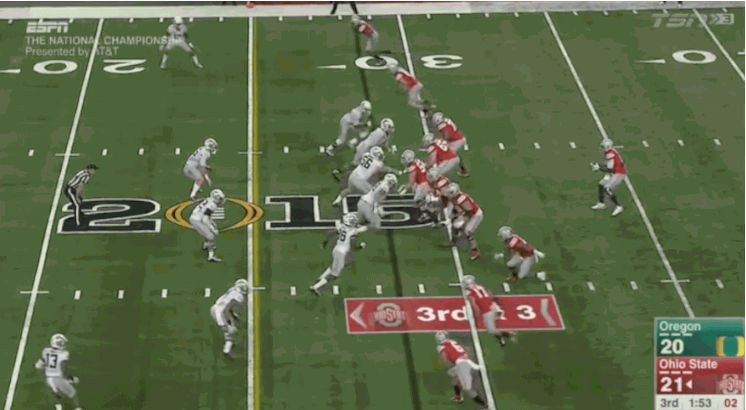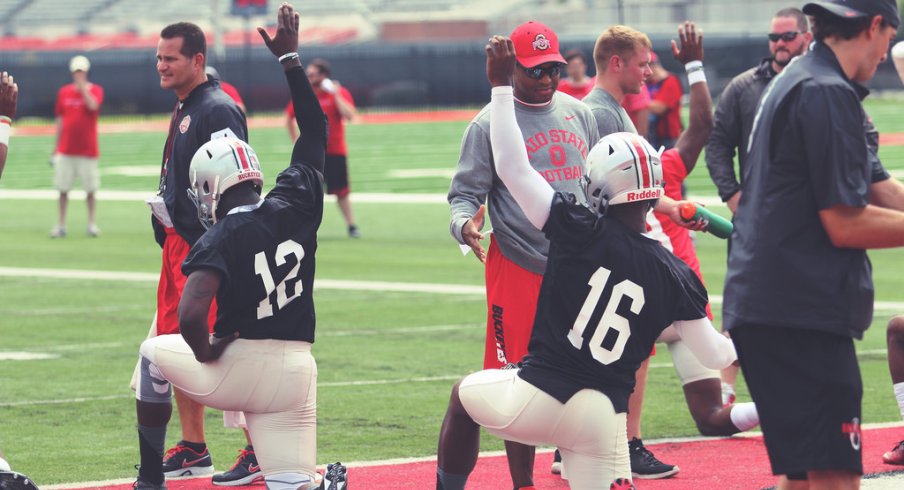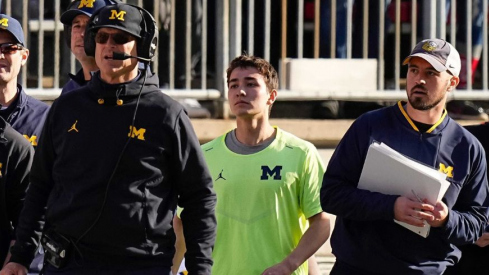Their resumes are certainly impressive.
One is the reigning Big Ten quarterback and freshman of the year, a third-team AP All-American, and set a school record with 44 touchdowns last fall.
The other was the Big Ten Championship game MVP, led the his team through the first college football playoff, and is predicted by some to be the top pick in the NFL draft this spring.
Urban Meyer and the Ohio State Buckeyes find themselves in a very unique situation this summer, trying to decide between two very talented players. While quarterback competitions certainly aren't rare, having to choose between a duo that have both shown an ability to win big games is, meaning every other fanbase in the nation would kill to see their team faced with the same 'dilemma.'
But for all the deserved praise heaped on both J.T. Barrett and Cardale Jones for leading OSU to a national championship, it's important to remember that we aren't talking about a choice between Tom Brady and Peyton Manning here. Both players have shown enough weaknesses during their time under center that the question of who deserves the starting quarterback job might not be the automatic win-win situation many have made it out to be.
One of the great things about college football is the development of players, both physically and mentally, from year-to-year. Plus, we're talking about one player with 12 career starts, and another with only three, meaning there is plenty of room both to still get much better. But none of us are in the meeting rooms or on the practice field for every play, so while the duo split reps in practice over the final two weeks of training camp, we only have the benefit of last year's film.
In an attempt to predict the future, let's examine what both Barrett and Jones have shown us in the past.
J.T. Barrett
Barrett initially won the job over Jones last fall after Braxton Miller's shoulder injury thanks to his ability to distribute the ball to the numerous play-makers around him, allowing Meyer's offense to run at full capacity. The Buckeyes' 'power-spread' attack traditionally requires a quarterback to move quickly and decisively immediately after the snap, a role for which Barrett showed he is the perfect fit.
First and foremost, Meyer requires his quarterback to be a threat in the running game, giving the offense a numeric advantage thanks to the option game. While Miller, and Terrelle Pryor before him, never fully mastered the art of reading the designated option defender during their time under center in Columbus, Barrett is a master.
As we see in the example below, Barrett makes two prefect reads within the span of as many seconds. First recognizing the crashing defensive end (#98) on the inside handoff to Ezekiel Elliott, Barrett pulls the ball before immediately identifying the force defender (#4) and making a pitch to Curtis Samuel to get the ball on the outside for a big gain.
The option doesn't work well though if the quarterback himself is not a threat with the ball in his hands. In today's game, defensive coaches are able to determine before every game if they'd rather have the ball in the hands of the running back or the QB, and will teach the option defenders to force a give or a keep on every play until the scheme backfires.
Against Penn State such a plan was put in place, as the Nittany Lions seemed determined to keep Elliott from beating them, much as Virginia Tech had done in their week two upset of Ohio State. But Barrett's legs proved to be too much for his opponents that night, effectively becoming the engine of the OSU offense in the second half and overtimes.

But the running game is of course only half of the equation for a quarterback. After a disastrous outing against the Hokies, Barrett rebounded nicely and showed excellent patience in the pocket, progressing through his check-downs and not being scared to dump off to a back, once again ensuring the ball was in the hands of a dangerous runner on the outside.

Barrett showed great precision in the short and intermediate passing games, completing a conference-leading 64 percent of his passes. His deep balls, however appeared to be a weaker part of his game, as many of his 10 interceptions came from inaccurate throws downfield.
For this reason, much of the Buckeye passing game often tried to stretch defenses horizontally, executing three-step passing routes like slants and hitches to the outside much more than they had in Meyer's previous two seasons. Barrett showed excellent footwork and throwing mechanics in these situations, not only leading his receiver to open space, but also placing passes right on their hands.

But these fundamentals didn't translate against a pass rush, as Barrett often forced the ball out much too quickly. According to the excellent analysis of Pro Football Focus, his completion percentage dropped to only 44 percent when under pressure, which all but guarantees defenses will be bringing extra pressure should he win the job.

Cardale Jones
Making this competition more interesting is the complete contrast in style brought by Jones, the Cleveland Glenville product. While Barrett fits nicely into Meyer's base offenses of the past, Jones' pure talent changes the geometry of the field for both the Buckeyes and their opponents.

With perhaps the strongest arm in college (or even pro) football, Jones forces defenses to play deep on every play, which opens up the Buckeye running game on its own. With safeties in Cover 4 schemes now more worried about a pass going over their heads at any time, they're less likely to sneak into the box and provide extra support against the run. It is of no surprise that the three biggest games of Elliott's career coincided with Jones' starts.
In order to get the ball downfield though, his receivers must have time to get there first, meaning Jones has to stand longer in the pocket. The big man separates himself from Barrett here, as he shown a consistent ability to escape the pass rush, as he's both too big and strong to come down from an arm tackle, but athletic enough to use his feet to out-run defensive linemen.
Perhaps most impressively, Jones is able to keep his eyes downfield while moving in the pocket, keeping his under-pressure completion percentage at a solid 55 percent. But Jones' doesn't just have a cannon for an arm, launching deep balls all over the field. His accuracy on said throws is what really has the attention of pro scouts, as he completes 40-yard throws with less effort than some of his counterparts put into a throw half that length.

Jones isn't a pure throwing threat either, as Alabama defensive coordinator pointed out last month during an interview at SEC media days:
"We didn’t promote him enough and they didn’t value his talents enough, and he came in — we thought he was a really good passer. Well, he ran the ball well, too. Well, we had not seen him run the ball . . . and not a runner like (Bama QB) Blake (Sims) and not a runner like their other guy, just big.”
At 6-foot-5 and 250+ lbs, Jones runs through defenders with relative ease, including opposing nose tackles.

But while Jones possesses the requisite threat needed as a runner, his decision-making in the designed run game leaves plenty to be desired. Jones doesn't seem to possess the same natural vision as a runner to find holes between the tackles, and is the most effective in the open field when in one-on-one situations with a defender.
As a result, the read-option was effectively removed from the playbook during his three games as a starter. While the coaching staff was able to hide this inefficiency for a few games, it's hard to imagine an Urban Meyer offense that doesn't regularly feature a running option at quarterback.
The Verdict
The good news for Jones is that mastering the option is certainly a teachable trait, especially since he doesn't seem to shy away from contact, as can often be the case with option quarterbacks. Instead, he seems to simply believe he can run over anyone in his way instead of letting the scheme dictate the decision. It's also easy to simulate the option situations in practice, which will give Meyer and his staff ample time to evaluate whether or not he's capable of running the entire offense at full throttle.
But if Jones doesn't take a major step forward in that department, it's hard to see him as the ultimate winner of this competition, based on what we've seen on film. The situation is very similar to that of Team USA basketball, who always hand over point guard reins to Chris Paul instead of more physically talented players like Russell Westbrook or Kyrie Irving. Paul can certainly create his own shot, but his real value comes in his ability to get the ball to LeBron James or Kevin Durant when they're in a position to score.
With Paul leading the charge, Team USA gets the most of all five players on the court, much as OSU gets the most from all six skill players on the field when Barrett takes the snap. Urban Meyer has spent the past few years stocking the cupboard with weapons in the open field, and the redshirt-sophomore from Texas allows Meyer to get the ball into the hands of those dangerous runners with greater frequency and efficiency.
Jones is still the better pro prospect, as his skill set is perfectly matched to what is asked of NFL QBs. But for the Buckeyes to repeat as National Champions, they'll need all their stars be major contributors on offense, constantly keeping defenses on their toes. From how things look now, Barrett is the man to ensure they will.





